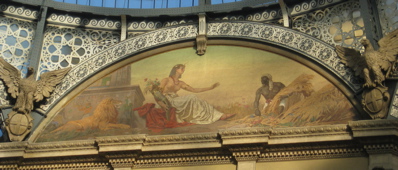After a day in Pisa, Mom and Dad took a quick afternoon trip through Lucca before spending a couple days in the Cinque Terre region. I visited back in November so it was nice to go back and relax again, however, pictures are posted earlier. After leaving Cinque Terre, we spent an afternoon in Genoa and then onto Milan. Many people find Milan to be disappointing. But, it's Italy's financial and industrial capital. It's not situated in a really beautiful area, it's basically flat. However, it is where economic opportunity lies in Italy. I actually engaged with Milan and found wonderful things to see. The heart of it all is the Brera district. The Vittorio Emmanuele Galleria, Duomo, Brera Gallery, of course, the high fashion district are all concentrated in this small area.
One of Milan's most famous residents was Leonardo da Vinci. The "Cenacolo" (aka The Last Supper) is painted in the refectory of a nearby Chiesa Santa Maria delle Grazie. To see it, reservations need to be made months in advance. Alas, we didn't see it.
Leonardo faces this somewhat nondescript building, but it is the famed La Scala, purported to be the best opera house in the world. Recently renovated, performances are back and I hope to return to Milan and take in the La Scala experience.
One of the famous landmarks in Milan is the Galleria Vittorio Emmanuele.
It's a four story skylighted mall (perhaps one of the first in the world). It was a wonder when constructed in the 1870's (honoring Vittorio Emmanuele the first king of the reunified Italy) because it was covered AND lighted.
It's not only home of great shopping, but some interesting art. The two arms of the mall meet at a cross. In the four corners, near the ceiling are four mosaics that represent four of the seven continents of the world. It's a quiz, I'll post the answers at the end. Here's Number 1.
Number 2
Number 3
Number 4
There are also fun mosaics on the ground. Here's one of the symbol of the city of Torino (means little bull in Italian). The legend has it that if you spin yourself while stepping on the bulls balls, you'll have good luck. Here's Mom taking a spin.
Kitty corner from the Galleria is Milan's Duomo, and yes, if you think the facade is out of control.....it is. It's as if they were trying to please everyone at the same time, but mainly it's Gothic.
The Duomo was built to hold the entire population of Milan at the time, which was 40,000 residents. It's enormous.
There is tons of art inside, here's a statue of the martyr St. Bartolomeo, who was skinned alive. One of Leonardo's students dissected a body (in the name of science and outlawed by the church) and he carved this statue.
You can also get onto the roof of the Duomo.
You can walk amongst the spires and see the statues and sculptures that are there (there are thousands). Alas, because of a military procession that morning, the great spire walk down the axis of the Duomo was closed.
From the Duomo roof, I saw these two towers of the skyline, which I thought was a great juxtaposition of old and new.
While in Milan, I visited two museums, one the Museum of the History of the Italian Risorgimento (I've become somewhat fascinated by Italian history). It was all in Italian, but I could parse together the majority of what was being written. The other museum is the Brera Art Gallery, the front is shown here.
The Brera is actually a working art school with the second floor being a Pinocoteca (painting gallery). The building is built around a courtyard. This is a a view (from the rear, which sometimes is the better view I think) of Napoleon done by my favorite sculptor, Antonio Canova.
The Brera, being a school, also has a working restoration lab. This lab is on display and it was cool to see ALL the different machines they use. Unfortunately, there wasn't any live action when I was there.
Even though it's illegal to take pictures, I just do anyway. I get so excited (as you all probably now know) when I see a piece of art I've studied. Here is Andrea Mantegna's "Foreshortend Christ". It's a great example of the emerging mastery of different types of perspective, in this case foreshortening, defined as "the visual contraction of an object that extends back in space at an angle perpendicular to the plane of sight."
This is Piero della Francesca's "Enthroned Madonna and Saints Adored by Federico da Montefeltro". It shows Piero's interest and mastery of light and reflected light. He is amazing at making each figure a separate entity and distinct from the background and from the figures around them.
Il Bacio, by Hayez.
Raphael's "Marriage of the Virgin". Done by Raphael when he was 20 years old. The soft light, almost syrupy in its quality. But the awesome thing is that he uses one point perspective and that point is the sky through the open door. He's also referencing other Renaissance artists, especially Brunelleschi's centrally planned domed arcade.
The answers to the mosaics are 1) Africa 2) North America 3) Europe and 4) Asia
The answers to the mosaics are 1) Africa 2) North America 3) Europe and 4) Asia






















No comments:
Post a Comment